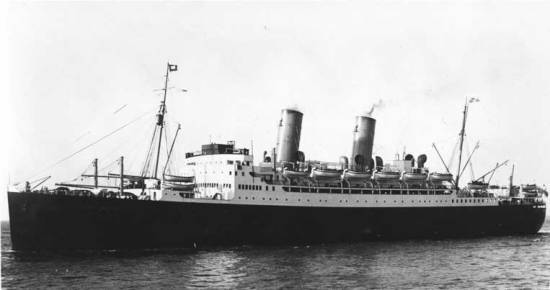Duchess of Atholl
British Steam passenger ship

Photo courtesy of the Allen Collection
| Name | Duchess of Atholl | ||
| Type: | Steam passenger ship | ||
| Tonnage | 20,119 tons (one of the largest ships sunk). | ||
| Completed | 1928 - W. Beardmore & Co Ltd, Dalmuir | ||
| Owner | Canadian Pacific Steamships Ltd, Montreal | ||
| Homeport | London | ||
| Date of attack | 10 Oct 1942 | Nationality: | |
| Fate | Sunk by U-178 (Hans Ibbeken) | ||
| Position | 7° 03'S, 11° 12'W - Grid FM 3734 | ||
| Complement | 825 (4 dead and 821 survivors). | ||
| Convoy | |||
| Route | Durban - Capetown (3 Oct) – Freetown - UK | ||
| Cargo | 3500 tons of general cargo and 534 passengers | ||
| History | Completed in June 1928 | ||
| Notes on event | At 08.29 hours on 10 Oct 1942 the unescorted Duchess of Atholl (Master Henry Allinson Moore) was hit on the port side in the center of the engine room by one of two stern torpedoes fired by U-178 while steaming on a zigzag course at 17 knots about 200 miles east-northeast of Ascension Island. The U-boat had spotted her about 35 minutes earlier, shortly before sunrise, in a distance of 6000 meters and immediately attacked after diving. The ship lost speed after being hit, made an uncontrolled 180 degree turn to port and soon all lights went out and she became immobile due to the flooding of the engine room. At 08.37 hours, a second spread of two torpedoes was fired of which one struck about the same place like the first. The ship carried a crew of 265, 26 gunners (the ship was armed with one 6in, one 3in, four 20mm and four machine guns) and 534 passengers, consisting of 236 army personnel 196 naval personnel, 97 RAF personnel, five nurses and 291 civilian passengers, including many women and children. The master ordered to put all passengers in the lifeboats after the second hit, which was done without any untoward incident despite a moderate swell and trade wind. A coup de grâce missed at 09.18 hours, but another fired 3 minutes later struck on the starboard side underneath the forward mast abreast #3 hatch. The remaining crew members and the gunners abandoned ship after the third torpedo hit without difficulties with the master and first radio officer leaving as last men at 09.45 hours, after making sure that all confidential books, papers and nine special bags of mail had been thrown overboard. 26 of the 32 boats carried aboard were successfully launched, three had been destroyed by the explosions and another had to be abandoned after launching as it was too badly damaged. Four crew members were lost and two crew members and two passengers were injured. The Duchess of Atholl settled slowly until capsizing to port and sinking gently by the stern at 11.25 hours. U-178 surfaced a few minutes before the ship sank, approached some of the lifeboats and asked four men the usual questions about the name, cargo and port of destination before leaving the area. The wireless operators had send distress signals before abandoning ship, but only on the emergency station and could not receive a reply because the main wireless station and the receiver had been put out of order by the first torpedo explosion. They continued to broadcast their position with an emergency set carried in one of the lifeboats and kept contact with Ascension. Practically everybody in the lifeboats was sea sick due to a heavy swell until the weather moderated during the morning. At 10.30 hours on 11 October, the British ocean boarding vessel HMS Corinthian (F 103) (Cdr E.J.R Pollitt), which sailed from Ascension the day before to search for the survivors, sighted the lifeboats after using her direction finding equipment to follow the wireless broadcast. All survivors were picked up within five hours and landed at Freetown in the afternoon on 15 October, the vessel being escorted in by FFL Commandant Drogou (K 195). They boarded the British steam passenger ship Carnavon Castle and left Freetown for Glasgow on 18 October. | ||
| On board | We have details of 32 people who were on board. | ||
If you can help us with any additional information on this vessel then please contact us.
